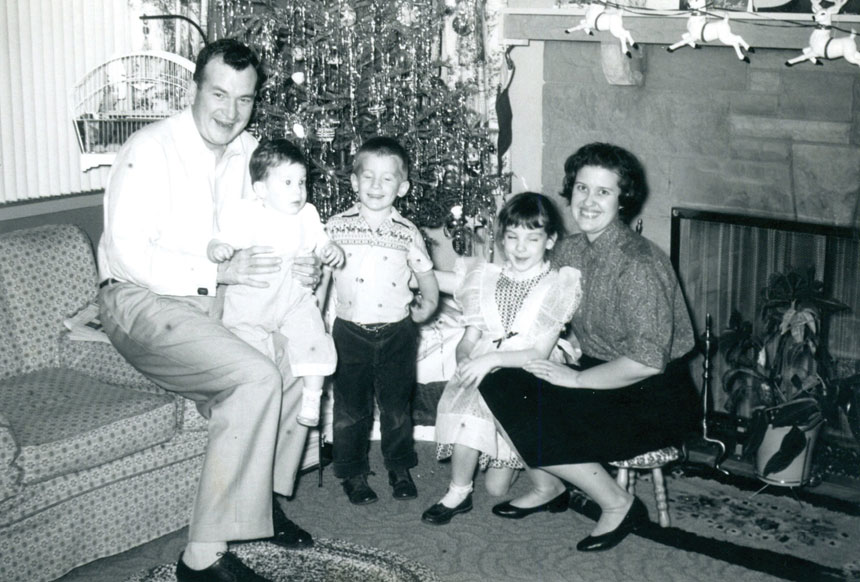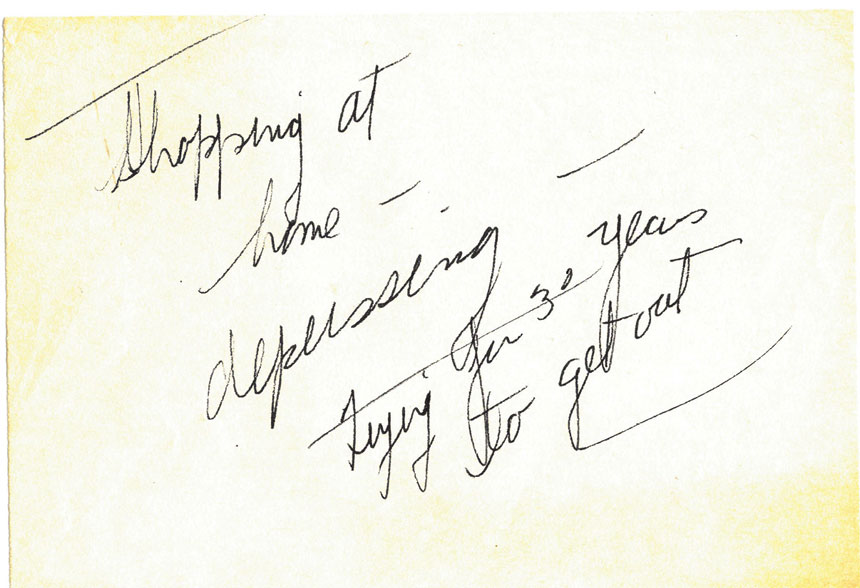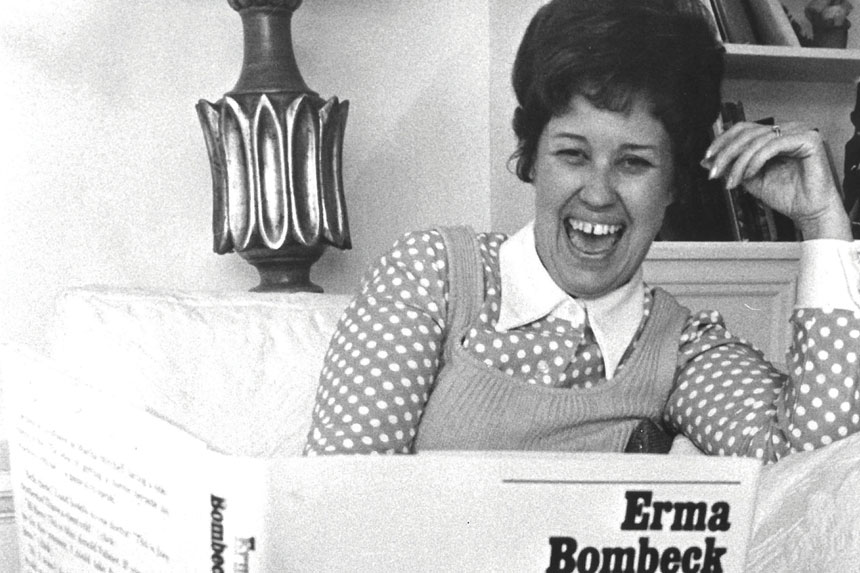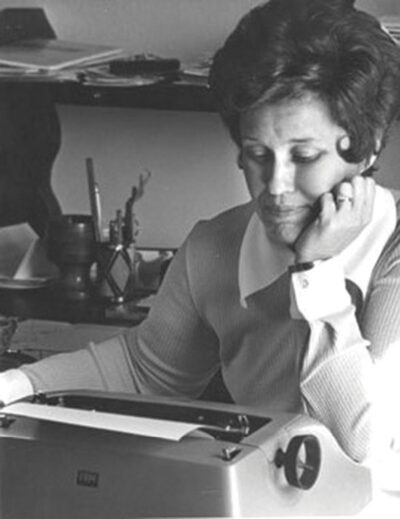She went nose to nose with a llama on national television … told the world she could never have an affair because she didn’t have the underwear for it … rode as grand marshal of the 1986 Tournament of Roses Parade … shopped on Beverly Hills’ Rodeo Drive with real-life pal Phyllis Diller, who dressed up as a nun … became a frequent guest on The Tonight Show with Johnny Carson … wrote more than 4,500 columns and 12 books, 9 of which made it onto the New York Times bestseller list … and appeared on ABC’s Good Morning America for more than a decade.

She is none other than Erma Bombeck, the housewife-turned-humorist who, until her death in 1996, poked gentle fun at the foibles of family life. Beloved by millions for her trademark wit — reflected in such well-crafted lines as “Marriage has no guarantees. If that’s what you’re looking for, go live with a car battery.” — Bombeck turned her take on the joys and challenges of marriage and parenthood into satirical columns that helped her legions of fans see the humor in their everyday lives. As Erma herself once put it, “If you can laugh at it, you can live with it.”
When she died at age 69 from complications resulting from a kidney transplant, Bombeck left behind a vast body of work — original manuscripts, columns, handwritten notes, speeches, articles, photographs, and memorabilia from her personal collection — preserved for years by her late husband, Bill, and children Betsy, Andy, and Matt. In 2020, the family donated the collection to her alma mater, the University of Dayton.
And much of that material is currently included in “Beyond the Byline: Erma Bombeck’s Story,” an interactive exhibition that celebrates the life and legacy of the great American humorist, on display through June 15, 2024, at the University of Dayton’s Roesch Library. The exhibition has a lengthy subtitle — “Writer. Housewife. Feminist. Humorist. Mother. Columnist. Pioneer.” — and for good reason.
“We wanted a title that showed the entire scope of what Erma accomplished,” says Kristina Schulz, university archivist and coordinator of special collections. “We wanted people to know we were looking at her entire life, not just her writing. To summarize all of that, we needed a comprehensive title that captured a little of everything.”

Bombeck started her writing career by contributing columns to her junior high school newspaper, The Owl. After graduating from the University of Dayton in 1949, she worked as a reporter for the Dayton Journal Herald and married Bill Bombeck the same year. In 1953, the couple welcomed their first child, and Bombeck left her writing job to take on the role of homemaker and mother.
It wasn’t until the last of her three children started school in 1964 that she began to write again. As she famously explained, she was “too old for a paper route and too young for Social Security.” She resumed her career writing humorous columns for the suburban weekly newspaper Kettering-Oakwood Times, for $3 each. The editor of the citywide Journal Herald spotted her work and offered her $50 a week for two columns. Three weeks later, the Newsday Newspaper Syndicate picked up her column At Wit’s End for national distribution. By the end of 1965, Erma was appearing in 36 newspapers nationwide. By the 1970s, 900 newspapers syndicated her column to an audience of 30 million readers.
Visitors to the exhibition will gain insight into the humorist’s writing process. In the beginning, typing on an IBM Selectric, Erma wrote her early columns in a cramped bedroom on a makeshift desk — a plank between cinder blocks. Later, in order to produce three columns a week, she locked herself away in a room with her typewriter for eight hours a day and kept herself on a strict schedule; her children recall slipping notes under her door while she was working. Even amid her busy career, she never stopped being a mother and a wife, saying, “I spend 90 percent of my time living scripts and 10 percent writing them.”
Behind the closed door, Erma began honing the formula for her columns, which she once summarized as “Hook ’em with the lead. Hold ’em with laughter. Exit with a quip they won’t forget.” Although the resulting work looks effortless, Erma was constantly revising her pieces until the last second. “It takes a long time to make it seem like it comes off the top of my head,” she once said.
When At Wit’s End began appearing in hundreds of newspapers across the country, Bombeck’s popularity soared. In 1975, she joined the original cast of Good Morning America and appeared regularly for 11 years. Erma’s comic pieces for the ABC program included an interview with Zsa Zsa Gabor on the actress’s king-size bed, a family whose “children” were robots, a clutter therapist, and a “garbologist” who studied mankind through the garbage we create. In an episode called “I Am a Bag,” Erma even allowed herself to become a piece of airport luggage traveling from the conveyor belt out to the belly of an airplane.
Her television work, political activism, and speaking engagements meant Erma traveled frequently. But when she got home, she always immediately started preparing dinner and doing laundry. “Doing the laundry keeps you humble,” she explained.
As extensive and engaging as the exhibition is, it’s dwarfed by the size of the entire Erma Bombeck Collection, which takes up 127 linear feet of space in the University of Dayton’s archives and is available for public viewing by appointment.
True Erma aficionados will appreciate taking a deep dive into this treasure trove, which includes materials as diverse as scrapbooks from Erma’s early years, galley proofs, photographs, and clippings from numerous national publications, like the feature story in Life that proclaimed her “The Socrates of the Ironing Board.” And of course the collection includes dozens of letters revealing her far-flung correspondence with all manner of folk. There’s a note from her friend Abigail Van Buren — aka Dear Abby — after a newspaper mistakenly put Erma’s photo next to her advice column: “Dear Erma — Will you get your face out of my column? Or should I get my column out of your face?” Another from Lucille Ball on learning the humorist appreciated her work: “I had no idea there was even time in your busy life for Lucy Ricardo and I couldn’t be more pleased.” And dozens of fan letters from readers around the country, some opening with lines like “Dear Erma, May I call you Erma? You seem like family,” while others offered ideas for her columns. And there is ample evidence that she read and responded to some of these ideas. In the margin of one letter proposing a column, Erma wrote, “Love it! Using it in a column, Sunday, June 13.”

Also included are scrawled notes that Bombeck wrote to herself with snippets of column ideas — everything from how to get bubble gum out of your hair to what kind of a person would go to a bra museum. Fans of Erma’s work can see how those notes translated into columns. For example, her famous quote, “Seize the day. Remember all those women on the Titanic who waved off the dessert cart,” had its origins on a scrap of paper reading, “Hit an iceberg. Titanic. Big dessert. Do it now!”
And then, of course, are the columns themselves, painstakingly clipped and saved in order of their publication by Erma’s longtime assistant, Norma Born. At present, the columns are still being indexed, but they’re easily retrievable by date.
No matter which box in the archives you ask to explore, you’ll uncover tidbits about Erma’s personality and humor. She would leave phone messages for her adult children, saying, “Make me a grandmother! Guess who?” When a fan met the diminutive 5-foot 2-inch humorist and said he thought she would be taller, Erma quipped, “Well, I write tall.” When asked in a parking lot if she was Erma Bombeck, she replied, “No, I’m Ann-Margret, but thank you anyway.”
Erma’s youngest son, Matt, a screenwriter in Los Angeles, helped oversee the transfer of his mother’s materials to the University of Dayton, which eventually resulted in more than 80 boxes of artifacts being shipped across the country from his parents’ home and two storage units.
“It’s been a long journey, but she’s absolutely home,” said Matt, who is delighted that the archives will play a role in keeping his mother’s work alive for generations to come. “It’s bittersweet, but we know the collection is going to the right place.”
What Matt wants the world to remember of his mother’s legacy is that “We can laugh at ourselves. We can laugh at our families. And we don’t have to take ourselves so seriously.”
For more information about the exhibition, visit udayton.edu/libraries/events/bombeck.php.
Rich Warren is a freelance journalist whose work has appeared in National Geographic Traveler, AAA World, AAA Explorer, Fodors.com, and AARP, among others.
This article is featured in the March/April 2024 issue of The Saturday Evening Post. Subscribe to the magazine for more art, inspiring stories, fiction, humor, and features from our archives.
Become a Saturday Evening Post member and enjoy unlimited access. Subscribe now





Comments
Read and loved Erma Bombeck’s column for many years in the 60’s. Still have many that I clipped and saved.
I, too, was an Erma Bombeck fan. I have three CHRISTMAS poems I wrote many years ago and I titled one “Christmas.. What is It? ” I refer to it as my Erma Bombeck poem, just because I wrote it in her style. The content is humorous. The ending is “Ah, well.. Merry Christmas anyway”…
I only raised two sons (in the 1960’s), but when I discovered Erma I thought “At last, someone who understands motherhood & marriage from a wife’s perspective!” How refreshing she was. Every time I read anything she wrote I ended up saying to myself, “At least there’s one other woman in the world who understands. If she can do it and survive, so can I.”
The best die too young!! Bless your feminist spirit, Erma. You brought Phillis Schlafly down to size.
Her books kept me sane and laughing while we were raising four children and two dogs…
Wow, in my column last week I said “I miss Erma Bombeck,” and I didn’t even know this article was going to be in the next issue! Fantastic piece, Rich.